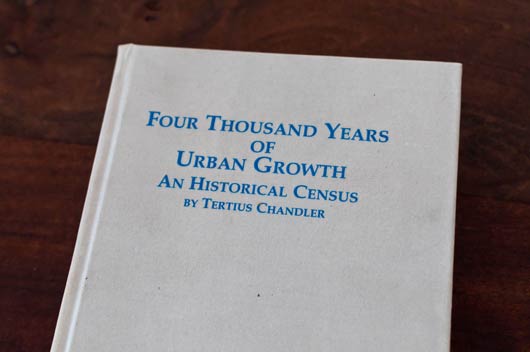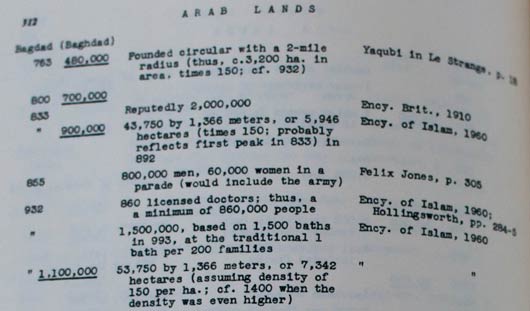
In his opening session at City Tracking, Stamen‘s Eric Rodenbeck showed us this book. Tertius Chandler’s Four Thousand Years of Urban Growth is a historical census of the world, derived from almost any source Chandler can find.
The book sat on the front table in the room we were sharing for the duration of the conference; a constant reminder of cities past and present, fallen and still-standing. I spent some time skimming through it, and found its contents as marvellous as Eric intimated.
In the first section of the book, Chandler tours the world, listing individual cities and their populations over time.

Here’s some of the listing for Dieppe, in France.
As well as a running total, there’s a citation for how that figure was derived. Sometimes, it’s based on direct quotation. But sometimes, it’s based on something more like a calculation. For instance, that 1600 figure for population is based on the number of churches in the city, and the average congregation size for those churches.

Here’s some of the listing for Baghdad, around the 8th century AD. In 932 AD, he uses several sources: the number of doctors (and how many citizens they served); the number of baths in the city; and the area the city covered. His final figure – of 1.1 million – is closest to the estimation derived from area. Chandler includes other figures in his notes, even if he’s not comfortable with their accuracy; see, for instance, the “reputedly 2,000,000” in 833, derived from the 1910 Encyclopedia Britannica. Chandler is clearly happier with the more conservative estimate derived from the area in the 1960 Encylopedia of Islam.

At the end of the book are tables of the world’s largest cities listed by era, with their populations. These are some of the listings for a few thousand years ago.
Finally, there’s a short textual appendix that serves as a short biography of the forty largest cities in each century, from 100-1970. From all his numbers and tables, Chandler weaves a narrative of how the world’s powers and economies have shifted and changed. For instance:
“China dominates the first city tables. At 1400 and 1500 it has each time 11 of the 40 cities. At 1600 China still has the topmost place, and 2 of the top 10, but Spain, with only one in the top 10, barely trails China overall with 6 to China’s 7. The Spanish cities include 1 in America, 1 in Portugal, and 3 in Italy. In 1700 China is ahead again with 9. In 1800 it has 9, as to 10 in the burgeoning British Empire, albeit the latter has only 1 on Britain itself. Britain and China thus rule just under half of all the 40 cities at 1800…”
It’s a marvellous artefact that’s now sadly hard to track down. As Eric quite rightly noted, those neat tables are crying out to be digitised in some form. It was kind of Eric to share Chandler’s remarkable book with us (and to let me share it with you) – and as a starting point for two days of talking about cities, it felt most appropriate.